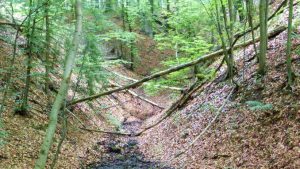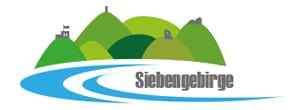Here were are in the Nature Park Siebengebirge, one of Germany’s oldest nature reserves. Do you hear the birds sing? Hikers enjoy the varied landscape, and a flora and fauna with many species.
Flora and fauna
Besides the donkeys at Mount Drachenfels, the fire salamander is one of the “landmarks” of the Siebengebirge. If you are lucky, you may hear a nightingale in the forest, or a kingfisher may fly past you. The Ofenkaulen caves, where once volcanic tuff was mined underground, are now a winter home for bats. If you walk out of the nature reserve towards the Rhine, you can hear the black-headed gulls from far away.
On a hike through the Siebengebirge, you will see countless flowers. Trees encounter different conditions at different places; therefore we have a variety of forest communities here, above all beech forests. Beeches are “our” trees.
Protecting nature
The Siebengebirge has been a nature reserve for a long time. Today, many endangered plants and animals have found a home here, and there are strict rules to ensure that they can live in peace. We humans are very welcome in these protected areas as long as we follow the rules of conduct, and there are hiking paths, forest inns and refuges for us.
Beeches and Wilderness
If the Siebengebirge was untouched nature, there would be mainly beeches here. Today, Central Europe is a centuries-old cultural landscape, densely populated and densely built-up. Many animals and plants have disappeared forever, and we scarcely have primeval forests left. It is a European concern to protect our remaining wilderness. Also in the Siebengebirge many paths lead into the wilderness.
Volcanic origin and quarries
Finally, a little bit of earth history. The Siebengebirge is of volcanic origin, and it is about 30 million years old. It almost fell victim to quarrying. On old pictures you can see the wounds the quarry had inflicted. Thanks to the dedicated work of the Verschönerungsverein für das Siebengebirge (VVS), the Siebengebirge is a wonderful place today.
National Geotope Siebengebirge
In May 2006, as a result of a nationwide competition, 77 objects in Germany were awarded the title of National Geotope, including the Siebengebirge. Closed quarries can also be geotopes. Here, you can see the different rock formations, and geologically trained people can use it to understand how a region was formed and what it has gone through over millions of years. In the Siebengebirge we have above all the abandoned quarry at Mount Weilberg and the outcrop walls at the mountains Drachenfels and Wolkenburg.

Siefen
Siefen are narrow, deep and wet valleys with a small mountain stream. In other words, gorge-like forest valleys with small streams, such as the Nachtigallental. There are many of them in the Siebengebirge.
So, they may have given it its name, maybe the locals once called it “Siefengebirge”, which translates as Siefen mountains. If we follow that theory, we assume that the name later became “Siebengebirge”, which translates to “Seven Mountains”(sieben = seven). This is obvious as well, since we have seven mountains that stand out. These are Drachenfels, Wolkenburg, Petersberg, Nonnenstromberg, Ölberg, Lohrberg und Löwenburg.
The German word “Siefen” describes a deeply indented moist valley. It goes back to the Middle Low German word “sîpe” for “humid lowland” or “small streams” (quoted from the German Wikipedia).
See ya in the Nature Park Siebengebirge!

Be the first to comment